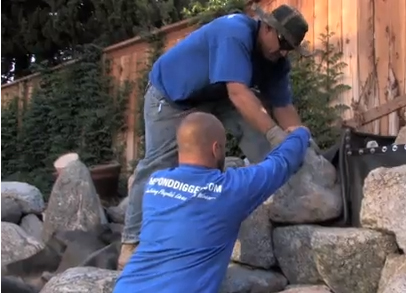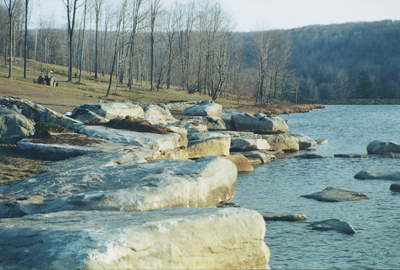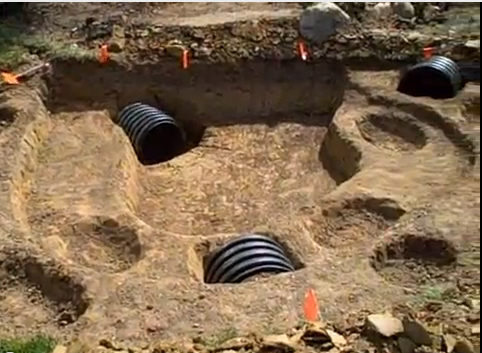boulders
I’m generally a low-key guy, but I love almost everything about building waterfalls. I like discussing a site’s potential with my clients. I like going to the supply yard and selecting stone. And while I don’t mind letting others take the lead with the digging, I do like laying out shelves and setting the pond’s interior contours in ways that will maximize
When you work on projects in which stone is commonly measured in the thousands of tons and streams are frequently described in fractions of miles, you’re not easily impressed by size. This job, however, was remarkably vast – a project driven by creative passion and a client’s desire to
We’ve been in the pond business long enough that we’ve seen just about everything – the good, the bad and the ugly. But even we were bowled over by the pond we found in the yard on display in the four videos listed below: We ran up against so many problems all in one place that it made sense to us to record our efforts in renovating the watershape and
By Steve Sandalis We recently completed a project that truly thrilled a pair of well-traveled,…
From postage-stamp miniatures to lake-scale behemoths, it’s no stretch to say that ponds come in all sizes. While it’s certainly true that big ones give their owners boundless options when it comes to creating large ecosystems that support plenty of fish and plants, we’ve learned
Last month, we began our discussion of a large pond, stream and waterfall system for a historic upper Midwest estate found on the forested shore of a scenic lake. As related there, the project was to include three major ponds and a series of complex waterfall structures connected by streams rising close to the top of the gently sloping property. To sum up, the space we were working with measured approximately 300 feet wide and 800 feet long – a large section of a 35-acre estate marked by scores of mature trees that largely governed the watershapes’ configurations. Moreover, as there were no natural rock formations or outcroppings on site, we faced the need to
We recently completed a project that truly thrilled a pair of well-traveled, highly educated clients: It was a large, complex waterfall-and-pond composition in the sloping backyard of an upscale home in an affluent southern California neighborhood. There were a number of reasons why the project worked so well, but if I had to break it down to one thing more than any other, it had to do with the range of edge treatments we used within the available space. On the side nearest the house, we established a clean lawn-meets-water detail – very disciplined in appearance and obviously man-made. Directly across the pond was a set of rugged waterfalls – much wilder and basically untamed. Bracketing those features, we filled shallow areas with emergent plants and hiding places for fish and frogs. It was a well thought out plan, certainly right for the space. But I know for a fact that
I see gardens as entire worlds unto themselves - as complete and alive and distinct rather than as simple decorative extensions of architecture. Whatever form they might take, these spaces should carry us back into the peaceful parts of ourselves and to the calm, clear realms of our minds and spirits. This outlook has, in my role as founder and principal of Marpa Design Studio of Boulder, Colo., led me to consider landscapes as integrated wholes rather than as cobbled assemblies of solutions to various problems. It's a positive philosophy and design approach that is fully on display in the project depicted on these pages. I was recommended by the architect, who was working with the owners of this sprawling Rocky Mountain estate on a major renovation of both the home and the surrounding land. From the start, I was told there was just one major theme in mind: The home and its surroundings were to look as natural as possible - as though everything had arisen organically from the roots of the mountains. Neither house nor grounds possessed that spirit at the time, and the landscape was particularly deficient. Indeed, the only pre-existing feature was a cracked
Creating watershapes and landscapes that are natural in appearance is always a challenge, says Ken Alperstein of Pinnacle Design, a firm that specializes in high-end projects related to top-flight golf courses. For this project in Shady Canyon, however, the ante was upped considerably by the site's location in an environmentally sensitive coastal canyon in southern California - a design challenge intensified by regulatory scrutiny every step of the way. It was a job that forced everyone involved to be on exactly the same page at all times. The landscapes and watershapes at the Shady Canyon Golf Club in Irvine, Calif., were developed by the Irvine Company as the heart of an upscale residential community. The wilderness area set aside for the course and its immediate surroundings had a subtle, bucolic charm all its own - a character the design team needed to





















